您好,登錄后才能下訂單哦!
您好,登錄后才能下訂單哦!
這篇文章主要介紹C#中單點登錄的示例分析,文中介紹的非常詳細,具有一定的參考價值,感興趣的小伙伴們一定要看完!
什么是單點登錄?
我想肯定有一部分人“望文生義”的認為單點登錄就是一個用戶只能在一處登錄,其實這是錯誤的理解(我記得我第一次也是這么理解的)。
單點登錄指的是多個子系統只需要登錄一個,其他系統不需要登錄了(一個瀏覽器內)。一個子系統退出,其他子系統也全部是退出狀態。
如果你還是不明白,我們舉個實際的例子把。比如億速云首頁:https://www.jb51.ne ,和億速云的搜索http://so.jb51.net 。這就是兩個系統(不同的域名)。如果你登錄其中一個,另一個也是登錄狀態。如果你退出一個,另一個也是退出狀態了。
那么這是怎么實現的呢?這就是我們今天要分析的問題了。
單點登錄(SSO)原理
首先我們需要一個認證中心(Service),和兩個子系統(Client)。
當瀏覽器第一次訪問Client1時,處于未登錄狀態 -> 302到認證中心(Service) -> 在Service的登錄頁面登錄(寫入Cookie記錄登錄信息) -> 302到Client1(寫入Cookie記錄登錄信息)第二次訪問Client1 -> 讀取Client1中Cookie登錄信息 -> Client1為登錄狀態
第一次訪問Client2 -> 讀取Client2中Cookie中的登錄信息 -> Client2為未登錄狀態 -> 302到在Service(讀取Service中的Cookie為登錄狀態) -> 302到Client2(寫入Cookie記錄登錄信息)
我們發現在訪問Client2的時候,中間時間經過了幾次302重定向,并沒有輸入用戶名密碼去登錄。用戶完全感覺不到,直接就是登錄狀態了。
圖解:
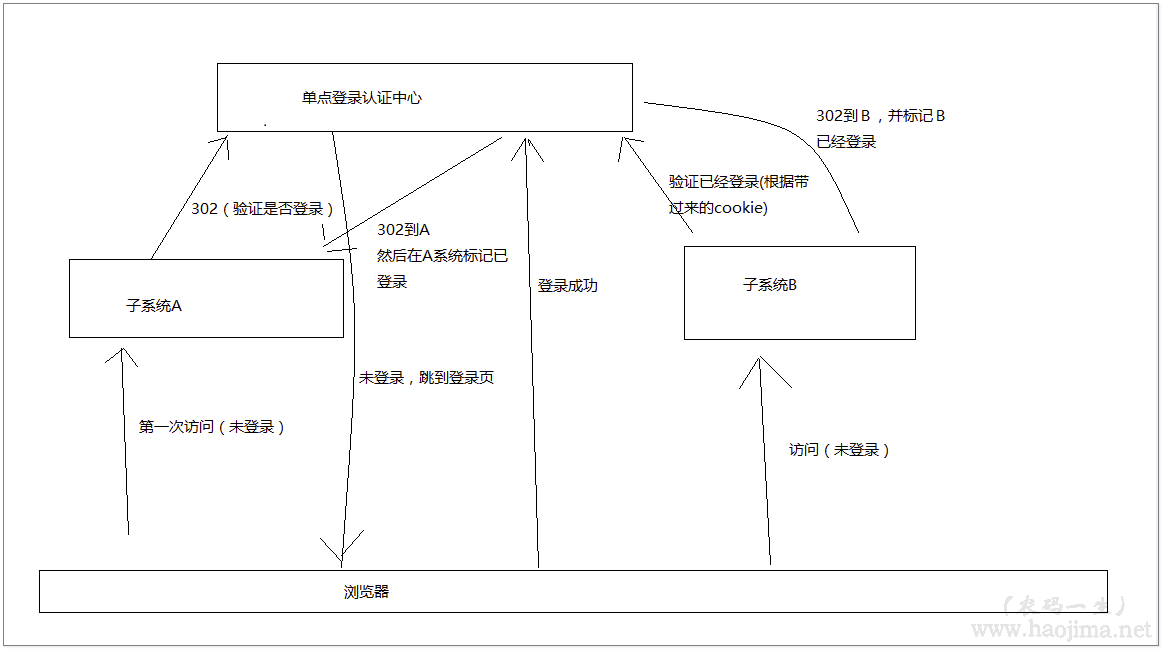
手擼一個SSO
環境:.NET Framework 4.5.2
Service:
/// <summary>
/// 登錄
/// </summary>
/// <param name="name"></param>
/// <param name="passWord"></param>
/// <param name="backUrl"></param>
/// <returns></returns>
[HttpPost]
public string Login(string name, string passWord, string backUrl)
{
if (true)//TODO:驗證用戶名密碼登錄
{
//用Session標識會話是登錄狀態
Session["user"] = "XX已經登錄";
//在認證中心 保存客戶端Client的登錄認證碼
TokenIds.Add(Session.SessionID, Guid.NewGuid());
}
else//驗證失敗重新登錄
{
return "/Home/Login";
}
return backUrl + "?tokenId=" + TokenIds[Session.SessionID];//生成一個tokenId 發放到客戶端
}Client:
public static List<string> Tokens = new List<string>();
public async Task<ActionResult> Index()
{
var tokenId = Request.QueryString["tokenId"];
//如果tokenId不為空,則是由Service302過來的。
if (tokenId != null)
{
using (HttpClient http = new HttpClient())
{
//驗證Tokend是否有效
var isValid = await http.GetStringAsync("http://localhost:8018/Home/TokenIdIsValid?tokenId=" + tokenId);
if (bool.Parse(isValid.ToString()))
{
if (!Tokens.Contains(tokenId))
{
//記錄登錄過的Client (主要是為了可以統一登出)
Tokens.Add(tokenId);
}
Session["token"] = tokenId;
}
}
}
//判斷是否是登錄狀態
if (Session["token"] == null || !Tokens.Contains(Session["token"].ToString()))
{
return Redirect("http://localhost:8018/Home/Verification?backUrl=http://localhost:26756/Home");
}
else
{
if (Session["token"] != null)
Session["token"] = null;
}
return View();
}效果圖:
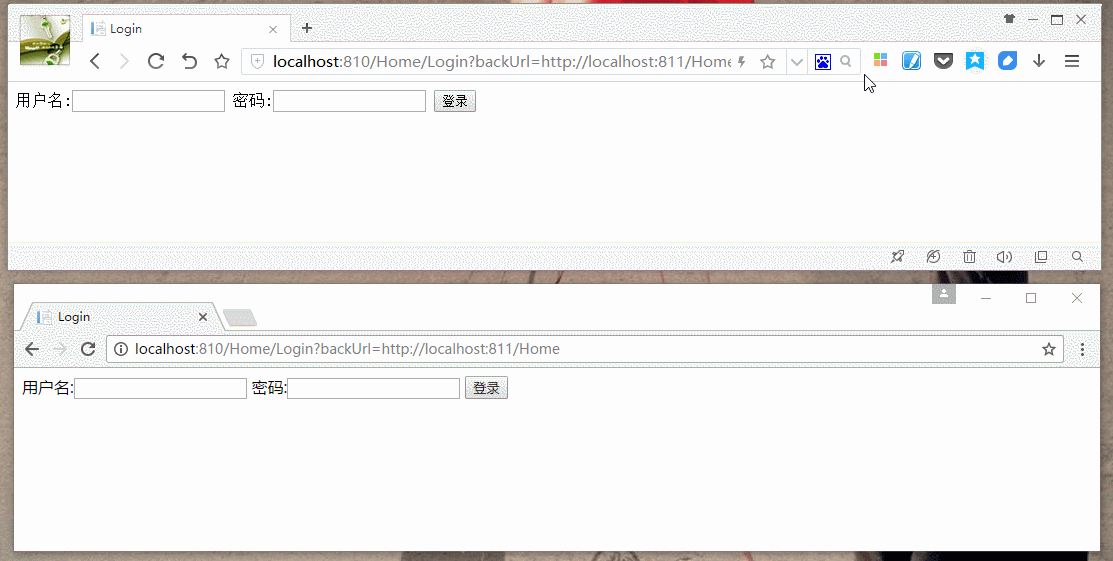
當然,這只是用較少的代碼擼了一個較簡單的SSO。僅用來理解,勿用于實際應用。
IdentityServer4實現SSO
環境:.NET Core 2.0
上面我們手擼了一個SSO,接下來我們看看.NET里的IdentityServer4怎么來使用SSO。
首先建一個IdentityServer4_SSO_Service(MVC項目),再建兩個IdentityServer4_SSO_Client(MVC項目)
在Service項目中用nuget導入IdentityServer4 2.0.2、IdentityServer4.AspNetIdentity 2.0.0、IdentityServer4.EntityFramework 2.0.0
在Client項目中用nuget導入IdentityModel 2.14.0
然后分別設置Service和Client項目啟動端口為 5001(Service)、5002(Client1)、5003(Client2)
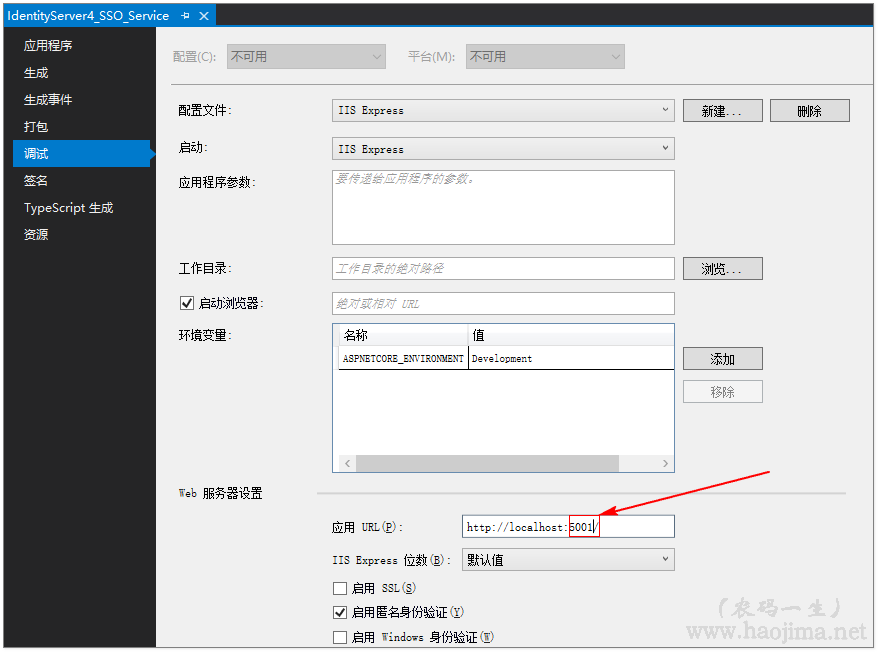
在Service中新建一個類Config:
public class Config
{
public static IEnumerable<IdentityResource> GetIdentityResources()
{
return new List<IdentityResource>
{
new IdentityResources.OpenId(),
new IdentityResources.Profile(),
};
}
public static IEnumerable<ApiResource> GetApiResources()
{
return new List<ApiResource>
{
new ApiResource("api1", "My API")
};
}
// 可以訪問的客戶端
public static IEnumerable<Client> GetClients()
{
return new List<Client>
{
// OpenID Connect hybrid flow and client credentials client (MVC)
//Client1
new Client
{
ClientId = "mvc1",
ClientName = "MVC Client1",
AllowedGrantTypes = GrantTypes.HybridAndClientCredentials,
RequireConsent = true,
ClientSecrets =
{
new Secret("secret".Sha256())
},
RedirectUris = { "http://localhost:5002/signin-oidc" }, //注意端口5002 是我們修改的Client的端口
PostLogoutRedirectUris = { "http://localhost:5002/signout-callback-oidc" },
AllowedScopes =
{
IdentityServerConstants.StandardScopes.OpenId,
IdentityServerConstants.StandardScopes.Profile,
"api1"
},
AllowOfflineAccess = true
},
//Client2
new Client
{
ClientId = "mvc2",
ClientName = "MVC Client2",
AllowedGrantTypes = GrantTypes.HybridAndClientCredentials,
RequireConsent = true,
ClientSecrets =
{
new Secret("secret".Sha256())
},
RedirectUris = { "http://localhost:5003/signin-oidc" },
PostLogoutRedirectUris = { "http://localhost:5003/signout-callback-oidc" },
AllowedScopes =
{
IdentityServerConstants.StandardScopes.OpenId,
IdentityServerConstants.StandardScopes.Profile,
"api1"
},
AllowOfflineAccess = true
}
};
}
}新增一個ApplicationDbContext類繼承于IdentityDbContext:
public class ApplicationDbContext : IdentityDbContext<IdentityUser>
{
public ApplicationDbContext(DbContextOptions<ApplicationDbContext> options)
: base(options)
{
}
protected override void OnModelCreating(ModelBuilder builder)
{
base.OnModelCreating(builder);
}
}在文件appsettings.json中配置數據庫連接字符串:
"ConnectionStrings": {
"DefaultConnection": "Server=(local);Database=IdentityServer4_Demo;Trusted_Connection=True;MultipleActiveResultSets=true"
}在文件Startup.cs的ConfigureServices方法中增加:
public void ConfigureServices(IServiceCollection services)
{
services.AddDbContext<ApplicationDbContext>(options =>
options.UseSqlServer(Configuration.GetConnectionString("DefaultConnection"))); //數據庫連接字符串
services.AddIdentity<IdentityUser, IdentityRole>()
.AddEntityFrameworkStores<ApplicationDbContext>()
.AddDefaultTokenProviders();
services.AddMvc();
string connectionString = Configuration.GetConnectionString("DefaultConnection");
var migrationsAssembly = typeof(Startup).GetTypeInfo().Assembly.GetName().Name;
services.AddIdentityServer()
.AddDeveloperSigningCredential()
.AddAspNetIdentity<IdentityUser>()
.AddConfigurationStore(options =>
{
options.ConfigureDbContext = builder =>
builder.UseSqlServer(connectionString,
sql => sql.MigrationsAssembly(migrationsAssembly));
})
.AddOperationalStore(options =>
{
options.ConfigureDbContext = builder =>
builder.UseSqlServer(connectionString,
sql => sql.MigrationsAssembly(migrationsAssembly));
options.EnableTokenCleanup = true;
options.TokenCleanupInterval = 30;
});
}并在Startup.cs文件里新增一個方法InitializeDatabase(初始化數據庫):
/// <summary>
/// 初始數據庫
/// </summary>
/// <param name="app"></param>
private void InitializeDatabase(IApplicationBuilder app)
{
using (var serviceScope = app.ApplicationServices.GetService<IServiceScopeFactory>().CreateScope())
{
serviceScope.ServiceProvider.GetRequiredService<ApplicationDbContext>().Database.Migrate();//執行數據庫遷移
serviceScope.ServiceProvider.GetRequiredService<PersistedGrantDbContext>().Database.Migrate();
var context = serviceScope.ServiceProvider.GetRequiredService<ConfigurationDbContext>();
context.Database.Migrate();
if (!context.Clients.Any())
{
foreach (var client in Config.GetClients())//循環添加 我們直接添加的 5002、5003 客戶端
{
context.Clients.Add(client.ToEntity());
}
context.SaveChanges();
}
if (!context.IdentityResources.Any())
{
foreach (var resource in Config.GetIdentityResources())
{
context.IdentityResources.Add(resource.ToEntity());
}
context.SaveChanges();
}
if (!context.ApiResources.Any())
{
foreach (var resource in Config.GetApiResources())
{
context.ApiResources.Add(resource.ToEntity());
}
context.SaveChanges();
}
}
}修改Configure方法:
public void Configure(IApplicationBuilder app, IHostingEnvironment env)
{
//初始化數據
InitializeDatabase(app);
if (env.IsDevelopment())
{
app.UseDeveloperExceptionPage();
app.UseBrowserLink();
app.UseDatabaseErrorPage();
}
else
{
app.UseExceptionHandler("/Home/Error");
}
app.UseStaticFiles();
app.UseIdentityServer();
app.UseMvc(routes =>
{
routes.MapRoute(
name: "default",
template: "{controller=Home}/{action=Index}/{id?}");
});
}然后新建一個AccountController控制器,分別實現注冊、登錄、登出等。
新建一個ConsentController控制器用于Client回調。
然后在Client的Startup.cs類里修改ConfigureServices方法:
public void ConfigureServices(IServiceCollection services)
{
services.AddMvc();
JwtSecurityTokenHandler.DefaultInboundClaimTypeMap.Clear();
services.AddAuthentication(options =>
{
options.DefaultScheme = "Cookies";
options.DefaultChallengeScheme = "oidc";
}).AddCookie("Cookies").AddOpenIdConnect("oidc", options =>
{
options.SignInScheme = "Cookies";
options.Authority = "http://localhost:5001";
options.RequireHttpsMetadata = false;
options.ClientId = "mvc2";
options.ClientSecret = "secret";
options.ResponseType = "code id_token";
options.SaveTokens = true;
options.GetClaimsFromUserInfoEndpoint = true;
options.Scope.Add("api1");
options.Scope.Add("offline_access");
});
}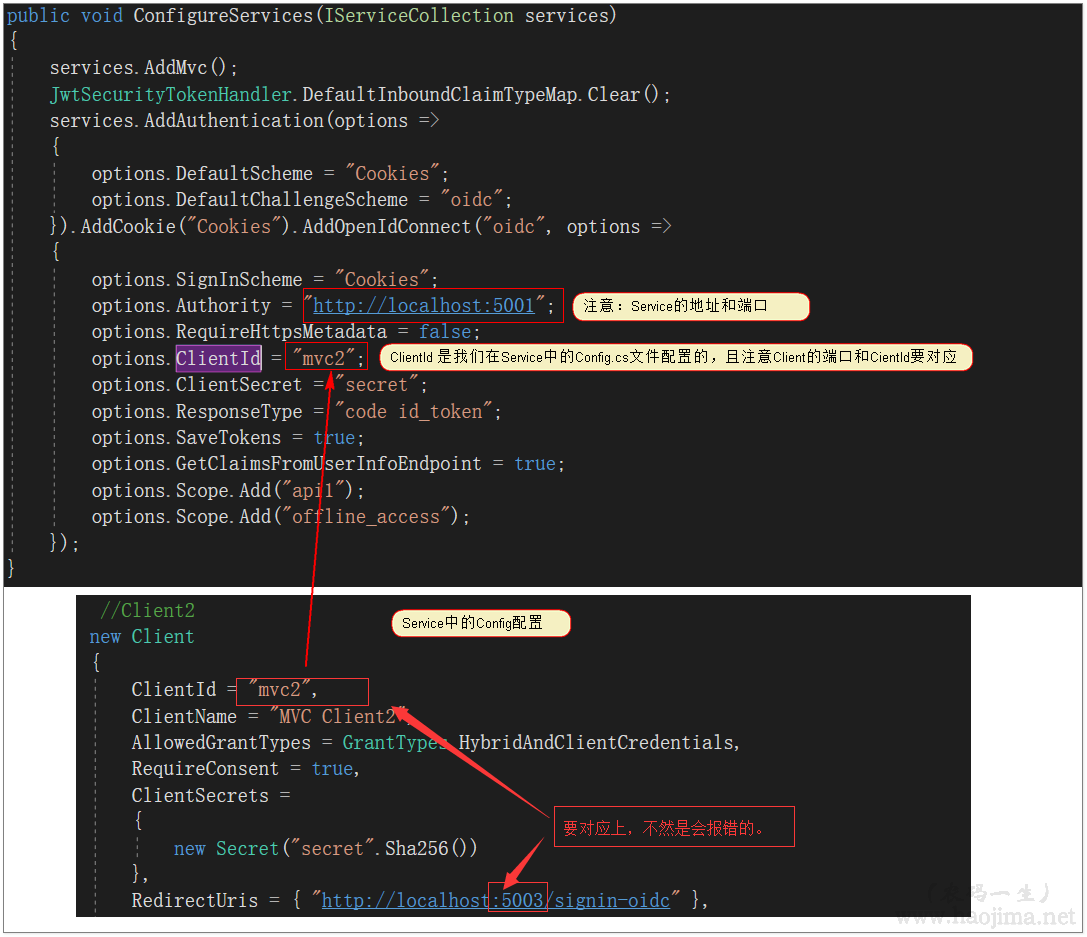
對于Client的身份認證就簡單了:
[Authorize]//身份認證
public IActionResult Index()
{
return View();
}
/// <summary>
/// 登出
/// </summary>
/// <returns></returns>
public async Task<IActionResult> Logout()
{
await HttpContext.SignOutAsync("Cookies");
await HttpContext.SignOutAsync("oidc");
return View("Index");
}效果圖:
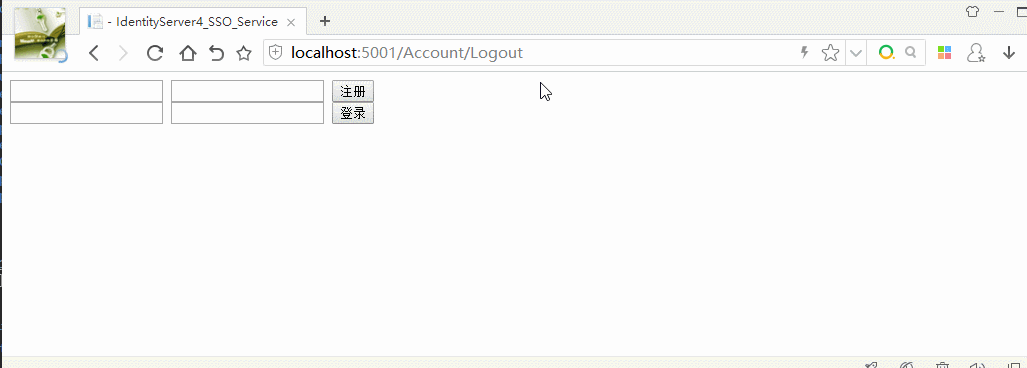
以上是“C#中單點登錄的示例分析”這篇文章的所有內容,感謝各位的閱讀!希望分享的內容對大家有幫助,更多相關知識,歡迎關注億速云行業資訊頻道!
免責聲明:本站發布的內容(圖片、視頻和文字)以原創、轉載和分享為主,文章觀點不代表本網站立場,如果涉及侵權請聯系站長郵箱:is@yisu.com進行舉報,并提供相關證據,一經查實,將立刻刪除涉嫌侵權內容。